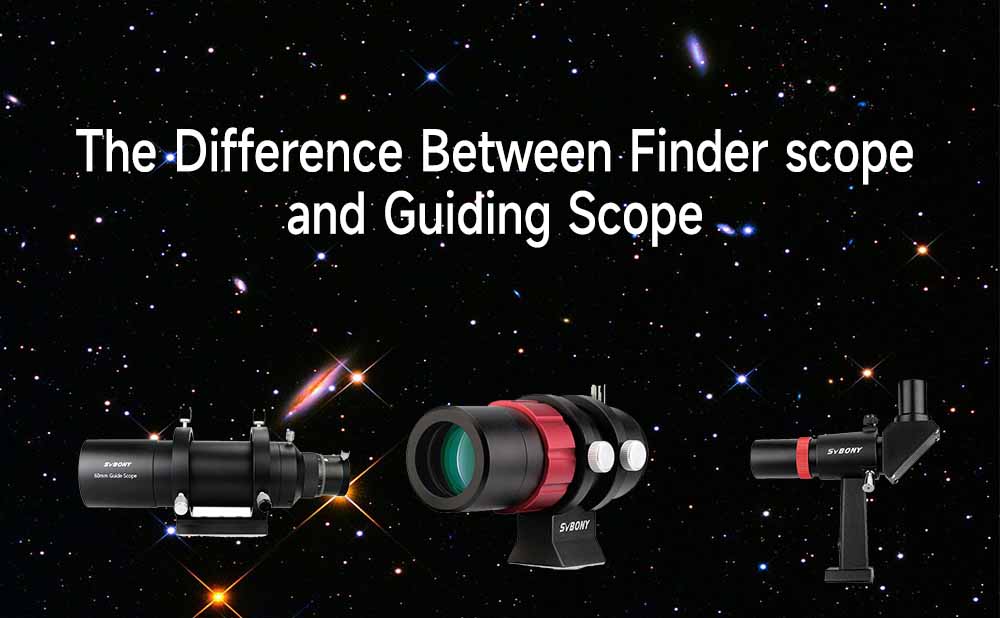Table of Contents

The Difference Between Finder cope and Guiding Scope
Whether in astronomical observation or deep-sky photography, precise targeting and tracking of celestial objects are crucial. In this process, finder scopes and guiding scopes serve as important auxiliary tools, each playing a unique role. While they are often confused, their functions, designs, and application scenarios have distinct differences. This article will delve into the characteristics of these two devices and their practical applications in astronomical observation, helping you better understand their significance in the quest to explore the mysteries of the universe.
Finderscope
Due to the small field of view of the primary mirror of the astronomical telescope, it is often very difficult to directly locate the observation target within the main mirror (since there are usually no other celestial objects for reference near the target). To quickly search for the celestial body to be observed, a low-magnification, wide-field small telescope is often attached next to the main mirror; this is called a finderscope. Finderscopes typically use a refractor design.
The optical axis of the finderscope is parallel to that of the main mirror, ensuring alignment with the target of the main mirror. The aperture of the finderscope's objective lens generally ranges from 50 to 100 mm, with a field of view between 30° and 50° and magnification from 7x to 20x. The focal plane usually contains a reticle for calibration purposes.
A finderscope like SV182 finder scope is a small telescope with both an objective lens and an eyepiece, typically featuring crosshairs that offer a much larger field of view than the main mirror. Before use, it must be calibrated with the main mirror. A target is placed at the center of the main mirror, and then the adjustment screws on the finderscope mount are used to align the reticle crosspoint with the target. When observing, placing the celestial object at the reticle crosspoint will ensure it also appears in the main mirror.

Guiding Scope
A guiding scope (SV106 guiding scope or SV165 guiding scope) is attached to the main telescope tube to monitor the guide star. Its purpose is to ensure that the main telescope accurately tracks the observed celestial body. If the guiding star deviates from its correct position, the telescope’s drive mechanism is adjusted to correct it. Guiding scopes generally use a refracting optical system, and the aperture size depends on the brightness of the guiding stars being used.


Guiding scopes typically only contain an objective lens. Since there will always be some error in polar alignment, during photography, the target may drift. A guiding scope helps detect the direction of this drift (by using a planet as a reference target), allowing adjustments to be made via the equatorial mount before the target becomes blurred in the image.
In ancient times, people used eyepieces with crosshairs or double crosshairs and relied on their eyes to detect drift, a practice commonly referred to as "manual guiding." Nowadays, automatic guiding systems are generally used, which rely on computers and software to detect the offset of stars on the guiding camera's sensor. A guiding camera replaces the human eye, while computers and guiding software act as the brain, and corresponding drives and cables take the place of human hands to control the equatorial mount for correction.
Conclusion
Whether in locating target celestial bodies or ensuring precise tracking, finderscopes and guiding scopes are indispensable tools for astronomy enthusiasts and professional astronomers alike. By understanding the differences and connections between them, we can not only enhance the efficiency of our observations but also enjoy more enriching experiences in the journey of exploring the vast universe. We hope this article provides valuable insights for your astronomical observations, making each experience under the night sky smoother and more successful!

There are no customer reviews yet . Leave a Reply !